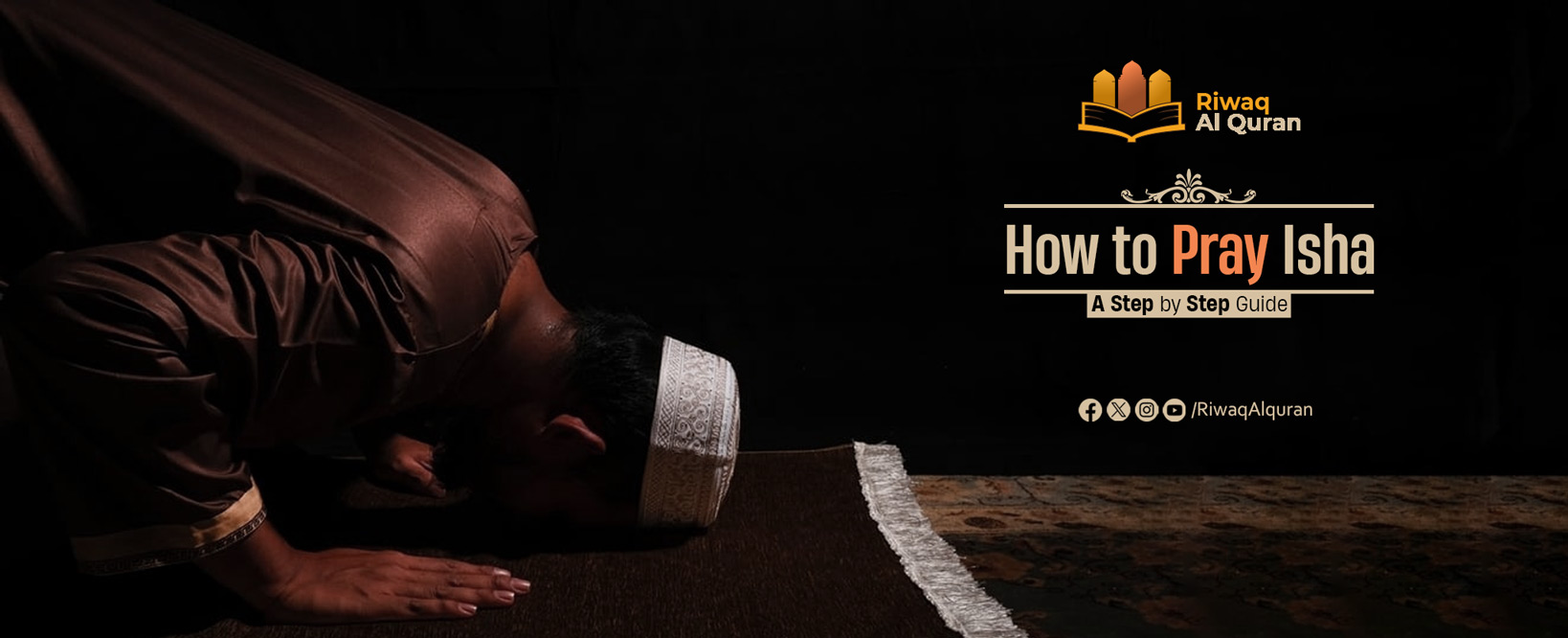The Isha prayer, also known as the night prayer, one of the five obligatory daily prayers in Islam, holds great significance. To perform the Isha prayer, start with wudu, then face the Qibla and say “Allahu Akbar.” Recite Al-Fatihah and another Surah, bow with “Subhana Rabbiyal Azeem,” stand, then prostrate twice with “Subhana Rabbiyal A’la.”
Repeat for the second rak’ah, then sit and recite Tashahhud. Complete two more rak’ahs with Al-Fatihah, then finish with Tashahhud and Tasleem, turning your head right and left with “Assalamu alaikum wa rahmatullah.”
Isha prayer is performed at night and consists of several steps within four continuous rakats. So, this guide will keep you learning more about the night prayer and how to perform the Isha prayer, including its importance, the number of rakats, besides the recommended sunnah for this prayer.
Renew your intention to learn Namaz and keep reading!
Table of Contents
What Is the Isha prayer?
The Isha prayer is the fifth and final obligatory prayer of the day in Islam. It is started after the Maghrib prayer until midnight and marks the end of the daily obligatory prayer cycle. This prayer also is a means to seek Allah’s guidance and forgiveness before retiring for the night.
Isha prayer has a unique position in Islam as the God’s Messenger said “No Salat is more burdensome to the hypocrites than the Fajr (dawn) prayer and the ‘Isha’ (night) prayer; and if they knew their merits, they would come to them even if they had to crawl to do so”.


How Many Rakat In Salat al Isha?
The Isha prayer consists of four obligatory rakats, the first two rakats performed out loud, and the last 2 rakats performed silently.
When To Perform the Isha prayer?
The Isha prayer must be performed before midnight and should not be delayed until after midnight. This is based on the Prophet’s hadith: “The time of ‘Isha is until midnight” (Narrated by Muslim).
Taking into account the duration of the night, which can vary. If the night is ten hours long, then it is not permissible to delay the prayer beyond the end of the fifth hour. Also, it depends on the geographic location and the time of year.
How To Perform Isha Prayer?
Isha namaz is one of the 5 obligatory prayers, offering significant benefits regarding its timing in the night.
To perform the Isha prayer, make your intention (niyyah) and perform wudu (ablution). Stand facing the Qibla, raise your hands, and say “Allahu Akbar.” Recite Surah Al-Fatihah and another Surah. Bow (ruku) says “Subhana Rabbiyal Azeem” three times, stand up, then prostrate (sujood) twice, saying “Subhana Rabbiyal A’la” each time.
Repeat these steps for the second rak’ah, then sit and recite the Tashahhud. Complete two more rak’ahs, reciting only Surah Al-Fatihah, and finish with the final Tashahhud and Tasleem, turning your head to the right and left saying “Assalamu alaikum wa rahmatullah.”
So let’s get ready to prepare well for this special rewarded prayer:
1. Get Ready For the Isha prayer
As we used to do every prayer, you should do the ritual cleansing for your spirit and body by the next two steps:
Set Up Your Intention (Niyyat)
Collect all of your materialistic and religious thoughts, don’t quit them, just plan them together to be involved in your dua throughout the Isha prayer.
This step will help you to relax and lower down the inner voices that distract you during the prayer!
Now, make your intention for the sake of Allah, to worship him, and to perform the Isha prayer.
Perform Wudu (Ablution)
Have wudu or renew it before heading to the Isha prayer. Wash your hands, rinse your mouth, sniff water into your nostrils, wash your face then rams, wipe your head, and finally wash your feet.
Wudu is a fundamental ritual in Islam. Whether it’s your first time performing wudu or you want to confirm your usual steps, refer to the guide below to learn all about the process:
Wudu Steps: How To Perform Wudu?
2. Stand upright And Face Mecca Direction (Qibla)
After completing wudu, position yourself at the center of your prayer mat, ensuring you are facing the Kaaba in Mecca. Take a moment to focus your intention (Niyyah) and mentally prepare for the Isha prayer.
With sincerity and devotion, raise your hands to your ears and proclaim the Takbeer, saying “Allahu Akbar”, marking the official start of your prayer.
3. The First Raka’h In the Isha prayer
The first Raka’h in the Isha prayer consists of many steps that would be repeated on the next three rakats, so pay attention to each step.
Now, fold your hands over your chest with the right hand over the left, and do what the next points explain.
Recite Surah Al-Fatihah And Another Portion Of Quran
Begin the first raka’h by chanting Al-Fatihah clearly (audibly), followed by another passage from the Quran.
Do you know The Easiest Quran Surahs to Memorize For Salah? Check it now.
Perform Ruku (Bowing)
Once you finish reciting Ayat, raise your hands to your earlobes and repeat takbeer “Allahu Akbar”.
Bow your body at the waist, place your hands on your knees, and silently say Ruku’s dua “Subhana Rabbiyal Azeem” (Glory to my Lord, the Most Great)” three times.
Stand Up After Ruku
Rise from the bowing position to the standing position (Qiyam), and lift up your hands to your ears, while saying the takbir words “Allahu Akbar”.
Then silently, chant I’tidal dua, which is “Sami’Allahu liman hamidah, Rabbana lakal hamd”.
Go Into First Sujood (Prostration)
Move from I’tidal position to Sujud. While facing the qiblah, kneeling down your body till your forehead and nose touch the ground, besides resting your palms against the floor.
Recite Sujud dua by saying “Subhana Rabbiyal A’la” (Glory to my Lord, the Most High) silently three times.
Raise your body back, put your hands on your thighs and knees, and recite Jalsa position dua, saying “Rabbighfirli”; i.e., (Oh Allah, forgive me).
Shift To Second Sujood Again
Say “Allahu Akbar”, then return to prostration for the second time, and chant sujood dua three times silently, by saying “Subhana Rabbiyal A’la” (Glory to my Lord, the Most High).
Sit up to Jalsa’s position between two sujoods again, and spell out “Rabbighfirli” (Oh Allah, forgive me).
4. The Second Raka’h In the Isha prayer
Stand up for the second rak’ah and repeat the same steps as the first rak’ah. Follow the below procedures:
Back To Qiyam (Standing Position)
Straightening your posture from the Jalsa position and standing up, don’t forget to say takbeer words “Allahu Akbar”, and recite audibly surat al Fatiha in addition to another portion of the Quran.
Replicate the other steps from Ruku, I’tidal, and Sujud.
Spell Out First Tashahhud
After the second sujud, relax your set in the Jalsa position, lift up your index finger of the right hand straight, and recite:
“At-tahiyyatu Lillahi wa-salawatu wa’t-tayyibat, as-salamu ‘alayka ayyuhan-Nabiyyu wa rahmat-Allahi wa barakatuh. As-salamu ‘alayna wa ‘ala ‘ibad-Illah is-saliheen. ashhadu alla ilaha illallah wa ashhadu anna muhammadan ‘abduhu wa rasuluhu.”
Which means:
{All dominion and greatness are for Allah, and all the prayers and all good speech and action are for Him. Peace be upon you O Prophet, and likewise the Mercy of Allah and His Blessings. And peace be upon us, and upon the pious servants of Allah. I testify that none has the right to be worshiped except Allah, and I testify that Muhammad is His servant and Messenger.}
5. The Third And Fourth Raka’h In the Isha prayer
Finalize the first Tashahud, and go on with the next two rakats of the Isha prayer.
You should replicate everything you have done in the first two Rakats, and here’s a gentle reminder and the exceptions for the next procedures:
Complete The Last Two Rakats
We agreed on practicing all the steps we explained in the first 2 rakats, but there are some differences in the last part of the Isha prayer, like:
- Recite surah al Fatiha only in the third and fourth of the Isha prayer, without any additional passage from the Quran.
- Chanting in the last two rakats should be done silently.
Recite The Final Tashahhud
Again, after sitting up from the second sujud of the fourth raka’h, straight up your index finger and point it in line, and say the recitation for the final Tashahhud:
“At-tahiyyatu Lillahi wa-salawatu wa’t-tayyibat, as-salamu ‘alayka ayyuhan-Nabiyyu wa rahmat-Allahi wa barakatuh. As-salamu ‘alayna wa ‘ala ‘ibad-Illah is-saliheen. ashhadu alla ilaha illallah wa ashhadu anna muhammadan ‘abduhu wa rasuluhu.
Allahumma salli ala Muhammadiw wa ala aali Muhammadin, kama sallayta ala Ibraheema wa alaa aali Ibraheema, innaKa Hameedum Majeed. Allahumma baarik ‘ala Muhammadiw wa alaa aali Muhammadin, kamaa baarakta ala Ibraheema wa alaa aali Ibraheema, innaKa Hameedum Majeed.”
Conclude The Prayer And Do Tasleem
Finalize the final Tashahhud, re-posture your index finger against your knees again, then conclude the Isha prayer by turning your head to the right and then to the left, saying “Assalamu alaikum wa rahmatullah” each time.
Inside Riwaq Al Quran: Live Class Highlights
Take a closer look at authentic excerpts from our live classes. At Riwaq Al Quran, our instructors create a dynamic and supportive learning environment where students stay engaged, build confidence, and thrive in their studies.
How Do You Perform the Isha Sunnah Prayer?
The Isha prayer also includes optional (sunnah) prayers that are highly recommended to perform, and it’s proved by the prophet’s hadith:
“Whoever offers Isha salah in jama’ah it is as though he spent half the night in worship. And whoever offers fajr salah in jama’ah it is as though he spent the entire night in worship.”
The Isha Sunnah prayer consists of four rak’ahs performed after the obligatory Isha prayer. To perform the Isha prayer sunnah, you can pray it as 4 continuous raka’hs or split it into two rakats with independent Tashahhud then perform another two rakats.
To proceed with the Isha Sunnah prayer, just replicate the first two rakats of the Isha prayer but recite silently, and finish them up with the final Tashahhud after the second sujud of the second raka’h.
In addition to the two Sunnah rak’ahs, it is also recommended to pray three rak’ahs of Witr prayer after Isha, which can be prayed as three continuous rakats or two rak’ahs followed by one rak’ah.


Why Students Love Learning with Riwaq Al Quran
Hear directly from our students about how Riwaq Al Quran Academy has transformed their connection with the Book of Allah. Their experiences reflect the dedication, care, and quality that guide every step of our teaching.
Learn Quran, Arabic, And Islamic Studies Online With The Best Native Tutors
Riwaq Al Quran is a comprehensive online platform that offers personalized Quran, Arabic and Islamic Studies Online classes for individuals of all ages and backgrounds.
Their experienced instructors use a structured curriculum to cover Tajweed, Tafsir, and Memorization, providing easy and effective access to learning the Quran.
The advanced online classes allow for seamless communication and interaction between students and teachers. Join Riwaq Al Quran for a deeper connection with the Quran.
We offer several courses such as:
- Online courses for kids.
- Online Quran classes for kids and adults.
- Online Arabic courses
- Online Ijazah courses
- Online Islamic Studies courses.
Here are a sample of our set of Quran Courses that will be helpful for you:
- Online Tafseer Course: Delve into Quranic meanings with our insightful online Tafseer course.
- Noorani Qaida Online: Learn Quranic basics efficiently through our Noorani Qaida online program.
- Online Quran Recitation Course: Enhance Quranic recitation skills through our expert-led online course.
- Online Tajweed Classes: Master Tajweed rules for beautiful Quranic recitation in online classes.
- Quran Memorization Online Course: Memorize the Quran effectively with our specialized online memorization course.
- Online Qirat Course: Explore diverse Qirat styles with our comprehensive online Qirat course.
- Online Quran Classes for Kids: Nurture a love for the Quran in kids through interactive online classes.
Conclusion
The Isha prayer, the final obligatory prayer of the day in Islam, is performed at night and consists of four rakats. This guide covers the significance, timing, and steps for performing Isha prayer, including preparing through niyyah (intention) and wudu (ablution), and the proper sequence of actions such as reciting Surah Al-Fatihah, bowing (ruku), and prostrations (sujood).
The Isha prayer is vital for seeking Allah’s guidance and forgiveness. Additionally, it includes optional Sunnah prayers for further spiritual benefit. By following these steps, beginners can ensure they perform Isha prayer correctly and sincerely.
Finally, Performing the Isha prayer is such a significant act of worship that concludes the daily prayers.
By understanding and following the proper steps for the obligatory Isha prayer or the recommended four or two voluntary prayers, beginner Muslims can be confident and ensure their prayers are performed correctly and with the sincerity required to seek Allah’s blessings and forgiveness.
May Allah accept Prayer!


































